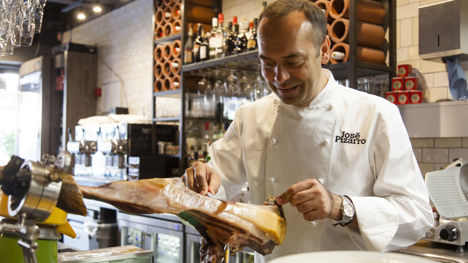
Taste of London 2016: José Pizarro
We stopped by José Pizarro’s celebrated tapas bar in Broadgate to find out what he’ll be serving at Taste of London this year and why his simple plate of Ibérico ham is one of the stars of the entire festival.
Taste of London 2016: José Pizarro
We stopped by José Pizarro’s celebrated tapas bar in Broadgate to find out what he’ll be serving at Taste of London this year and why his simple plate of Ibérico ham is one of the stars of the entire festival.
Small plates dominate London’s food scene at the moment, with every new restaurant seemingly doing away with the traditional three-course menu and instead offering little tastes of lots of different dishes. But it’s tapas, the famous Spanish bar snacks, which can be credited with kick starting this way of eating in the UK.
José Pizarro is one of the chefs that brought tapas into the realm of fine dining. While his three restaurants are very casual and relaxed, it’s the quality of ingredients he uses, along with his simple approach to cooking, that makes his flavourful dishes so special.
At Taste of London this year, José will be serving prawn fritters with aioli and a Basque hake dish, with clams and white asparagus on the side. What makes him such a popular addition to the festival each year isn’t necessarily his skills in the kitchen – it’s his plate of Iberico ham. But why is it so special?
‘I’m from Extremadura, one of the regions where acorns grow, which is what black Iberian pigs must eat to give jamón ibérico its distinctive flavour,’ José explains. ‘You get people trying to sell jamón ibérico, which is seasonal, from Barcelona. I ask them how they can sell it year-round if the acorn season is between October and April? They say some of it is not from acorn-fed pigs, which means it is not proper jamón ibérico. I only have it in stock all year because I buy it at its best then freeze it.’
A black Iberian pig is quite a small animal, and they usually have to be around two years old before they’re ready for slaughter. To develop the muscles, the pigs need exercise, so one hectare is required for each animal, making it an expensive process. ‘They will also eat around fifteen kilograms of acorns every day as they walk around, and all the oils from the acorns work their way into the muscle, tenderising them and making them more flavourful,’ says José. ‘Once the pigs are killed, the meat is salted and left for three to four years before the ham is ready. This means it takes five or six years to produce a good ham.’
All this work is worth it, however, as Ibérico ham is regarded as one of the finest cured meats in the world. Taste of London is the perfect opportunity to try it at its very best, especially if you want to know what it's like at its very best. ‘Jamón is very expensive, even more so now that it’s EU protected,’ says José. ‘People used to go to Spain and see something labelled jamón ibérico, but the animals weren’t necessarily treated as well as they should’ve been and were eating food other than acorns. The ham wasn’t bad, but it wasn’t Ibérico.’
Planning on heading to Taste of London this year? We've got an exclusive offer for Great British Chefs readers which can save you up to 19%. Visit the festival on Wednesday or Thursday for £13 or Friday for £17, or go along at the weekend for £25. Click here for more information.


